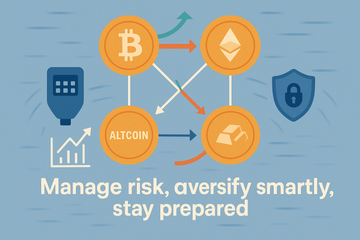Picture this: you're sipping your coffee, scrolling through your favorite crypto app, and suddenly, Bitcoin leaps while Ethereum takes a tumble. You pause, thinking, 'Aren't these two supposed to move together? Or is crypto just a free-for-all?' This, mates, is the essence of crypto correlation—one of those buzzwords you hear tossed around in trading chats, but what does it really mean and why should you care?
Let’s Break Down Crypto Correlation
Simply put, crypto correlation measures how the prices of digital assets dance around each other—or even with traditional heavyweights like gold and stocks. Sure, there’s math at play (something about coefficients and numbers between -1 and +1), but let’s keep things feeling real. If two coins move up and down together, that’s positive correlation. If one goes north while the other heads south, that’s negative. And if they couldn’t care less about each other? Zero correlation—like two strangers on a midnight train.
Why Crypto Likes to Keep Things Interesting
Honestly, crypto is still the new kid on Wall Street. Compared to stocks or gold, digital currencies don’t have decades of well-worn grooves for us to follow. Sometimes, you’ll watch Bitcoin and stocks rise together, especially when everyone’s feeling bullish about tech or innovation. Then, in other seasons—maybe during a crisis—crypto can cut its own path, ignoring the panic or joy elsewhere. Who hasn’t scratched their head at an inexplicable altcoin rally?
Portfolio Jenga: Building and Balancing with Correlation
Ever tried stacking Jenga blocks after two espressos? That, right there, is what building a crypto portfolio can feel like. Traders and pros alike crave diversification—spreading out their bets so one topple doesn’t bring the whole castle down. This is where correlation becomes your friend.
If Bitcoin and Ethereum both drop, your stack shakes. But maybe you tossed in an altcoin or two, or even a little traditional gold, hoping their trajectories differ. a low or even negative correlation helps cushion falls. That doesn’t mean you’re invincible, but you get the idea: it’s a way to soften the blow of market mood swings, especially in chaotic times.
- Post-2020 Trends: Many analysts noticed that since 2020, Bitcoin and Ethereum have sometimes moved more in sync with stock markets. Blame it on pandemic policies, inflation whispers, or changing investor appetites—the thread runs deep (Galaxy Asset Management).
- During the COVID-19 rally, Bitcoin shocked traditionalists by running alongside equities, not against them. So, you know, sometimes narratives get thrown out the window (Gemini).
- Fresh altcoins? Less track record means more guesswork. Their behavior isn’t as dependable. It’s like adding wild cards to your deck—both thrilling and sometimes stomach-churning.
Challenges: The Wild Card Factor
Now, before you start assuming you can nail crypto diversification with a casual glance at a few charts, let’s get real about the hiccups. Cryptos haven’t been around long enough to give us a rich, reliable history. Where stocks can look back decades, some tokens have only just learned to walk.
Another twist? Crypto markets are narrative-driven. Ever notice how the price can jump because of a single tweet, a regulatory rumor, or something even less tangible? It’s exhausting—and it means correlations can change on a dime. The speculative fog makes it hard to predict whether two coins will hold hands or turn into frenemies when the going gets rough.
Measurement Tools: More Than Just Guesswork
No need to feel lost in the numbers; there are tools built for the curious and the cautious alike. Platforms like Crypto Correlation Matrix let you eyeball market relationships in real time. Want to see how your favorites are behaving lately? Just a few clicks away. For those who love detail, platforms like TradingView even track how coins interact with stocks and commodities, so you’re never really flying blind (TradingView).
Ledger & Trezor: Your Hardware Knights
Bots, hacks, rogue browser extensions—it’s a digital jungle out there. Regardless of how closely your assets move or don’t move together, you want their security locked down. This is why tech leaders like Trezor and Ledger have become household names. Their wallets put your keys offline, away from hungry hackers and curious scripts. Even if your coins dance to different beats, the hardware wallet is like the sturdy shoe that keeps your feet on the ground.
Correlation Isn’t a Crystal Ball—But It’s Handy
You know what? At the risk of repeating myself—because it really matters—correlation won’t tell your future for you. Markets are moody creatures, and sometimes relationships change without warning. That said, understanding these connections can take your risk management up a notch. Is it foolproof? Absolutely not. But it’s a heck of a lot better than guessing blind.
Your Move: Reading, Reacting, and Riding the Waves
Check your assets, pay attention to the shifting sands, and keep your keys safe with trusted hardware. Scrutinize trends but don’t be a slave to them. If you ask around, every seasoned trader will tell you: sometimes the best risk control is just being ready for a surprise.
In conclusion—yeah, we’re wrapping up, but stick with me—crypto correlation is that quiet rhythm underlying the day-to-day noise. Learn its patterns, respect its quirks, and stay a little humble. The markets don’t owe you predictability, but they’ll reward the prepared. Ready to check your crypto’s next move?











